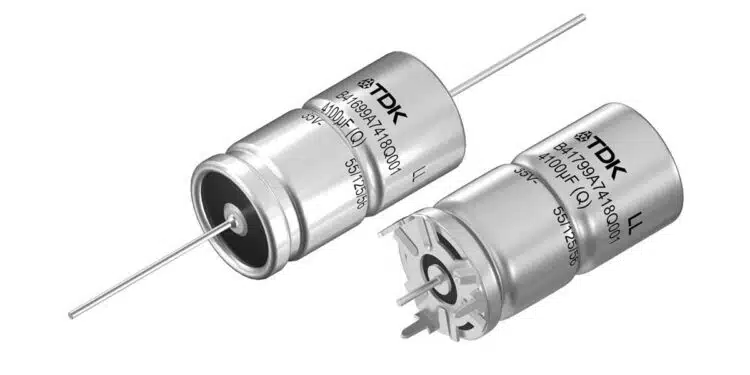TDK Corporation unveils the B41699 and B41799 series of ultra-compact aluminum electrolytic capacitors with axial-lead and soldering star designs, engineered to withstand operating temperatures of up to +140 °C.
Tailored for demanding automotive applications, these components offer a high-capacitance andhigh-ripple current solution in a space-saving format.
This enables designers to reduce the number of capacitors required in powertrain modules, such as electric power steering (EPS), fan control, and transmission systems.
The new capacitors are available for rated voltages of 25 V and 35 V, with capacitance values ranging from 1800 µF to 13,000 µF. They offer ripple currents of up to 34.6 A (IAC,max) at 10 kHz and +125 °C case temperature, supported by low ESR, over 4000 h of useful life (at +125 °C at rated voltage and rated ripple current), and vibration stability up to 60 g (optional).
This robustness is particularly advantageous in xEV platforms operating within a 12-V board net, where thermal stress, mechanical vibration, and compact integration are critical design factors.
The axial-lead version (B41699) and the soldering star version (B41799) provide flexible mounting options for horizontal, vertical, or busbar configurations. The dimensions vary from 16 x 25 mm and 21 x 49 mm (D x H). Their SIKOREL-based construction allows for a storage life of up to 15 years at +35 °C, while ensuring RoHS compatibility and compliance with AEC-Q200 standards. By achieving high capacitance in a minimized footprint, these capacitors empower engineers to simplify their designs without compromising performance.
Features
- Ultra compact design
- High ripple current capability
- Useful life 4000 h at up to +125 °C
- Vibration stability up to 60 g available upon request
- Low ESR at high frequency
- SIKOREL design – storage for up to 15 years at a temperature of up to +35 °C
- Compliance with AEC-Q200
- RoHS-compatible
Applications
- Automotive electronics































